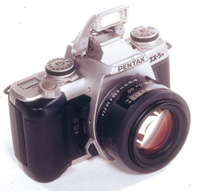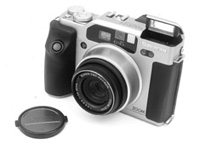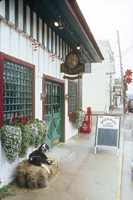Buying Tips
A Pros Picks In The Compact Class
The concept of carrying a small camera with you at all times certainly isn't new. Street photographers from the first half of the last century, whose main work was most often done with a cumbersome tripod and large format camera, eagerly adopted 35mm Leicas and twin-lens Rolleis when they were introduced in the early 1930s. Film quality of the day still dictated large format for the best results, but these new portable sidekicks allowed the capture of fleeting images that would have been lost without an ever-present small camera. "Small" in regard to camera size has always been a relative term, and it remains so today. The Rollei TLR, considered "miniature" during its heyday, would hardly be any photographer's idea of a pocket companion these days. Advancing film and camera miniaturization technologies have progressively enabled a particular level of picture quality to be produced by increasingly smaller film formats and cameras. The level of picture quality deemed acceptable is what separates the average consumer from pros and advanced amateurs. |
|||
An average consumer's yardstick of quality is a 4x6" print for the photo album, and practically any 35mm or APS camera made today, even inexpensive ones, can deliver the goods. More advanced photographers set the bar higher, with a sharp 8x10" print being the most frequently quoted criterion for a "grab-shot" camera. Pros can readily market prints of this size (or equivalent quality slides) to thousands of publications, thereby making it somewhat of a de facto standard. The task then becomes choosing a camera of min-imum bulk and weight capable of yielding a professionally sharp 8x10. Unfortunately, as bulk and weight dwindle, so do features and versatility; with every desirable feature on-board, you're quickly back up to a generously-dimensioned SLR. It's therefore necessary to strike a happy medium somewhere between bare-bones minimalism and a "kitchen sink special," insisting on only a sufficient roster of features appropriate to the type of photography you normally engage in. |
|||
How Small Is Small Enough? |
|||
If you're seeking a true compact that is pocketable, or at least wearable in a small belt case, how much camera do you require? Are scenics your main interest, or perhaps architectural details and abstracts presented by constantly shifting light and shadows? Then autofocus (AF) and built-in flash won't be all that important to you. Conversely, if impromptu people photography is your passion, AF and built-in fill flash will be high on your list of priorities. Lens Options If multiple focal lengths are mandatory, then pick a model with a zoom lens or interchangeable lenses. Keep in mind that a selection of interchangeable lenses doesn't take long to get unmanageably heavy and bulky, defeating the purpose of having a minimally intrusive, "rapid response" camera at your beck and call. A manageable strategy might be to keep your most often used focal length, say 28mm, on the camera, and carry just one alternative lens, perhaps a 90mm, for those situations when normality is mismatched to reality. |
|||
With zooms, it's necessary to reconcile yourself to the fact that top quality point-and-shoot zooms, in order to maintain evenness of light distribution across the image area and still be partially or totally retractable, will have a limited focal length range. Rather than despairing the lack of ability to meet any conceivable photo op, regard the short-range zoom as valuable insurance against all your pictures exhibiting the same perspective. Avoid point-and-shoots that have zooms with ridiculously wide focal length ranges. While most consumers will be content, my impression of the results at the extremes of the range is that they aren't up to professional standards. Speed And Flash |
|||
How about flash? While the small, built-in flashes don't have much range, they are a handy and effective daylight fill source in the 6-10' range where it's most needed. If you need to use a more powerful auxiliary flash unit on occasion, make sure any proposed camera has the necessary connection facility. Some have no provision for any flash other than the built-in one, several feature a hot shoe, but few have PC sockets. Also, try to avoid cameras with auto-activating, pop-up flash units that have no canceling override. A flash that fires unexpectedly at an inopportune time can be embarrassing at the least and can get you tossed out of many museums, religious shrines, and other sensitive locations. Do you enjoy taking nighttime cityscape time exposures when you travel? Then check to see if that new point-and-shoot has a tripod socket and a mechanical or electric cable release connection, as many don't. Is black and white photography your preferred means of expression? Then filter capability is a must. Unfortunately, very few point-and-shoots, even some ostensibly pro-oriented ones, offer this critical facility. |
|||
Some Cameras To Consider Is there a more modern camera that I'd rather have? In terms of size and weight vs. performance, no, but I do admit to occasionally longing for a few extra conveniences. I really like the Rollei QZ 35W and QZ 35T, but they're a little different size-wise from my Leica M4, and the cute but inconvenient separate flash unit gives me cause for pause. The Contax TVS II probably comes as close as any to my particular compact camera ideal, with AF, built-in flash, and a good little Zeiss zoom lens that accepts filters (as do the Rollei QZs). Contax's interchangeable lens, AF rangefinder G2 is another good candidate, but, like the Rollei QZs, marginal in the compactness department. |
|||
For a fixed, single focal length camera, the Nikon 35Ti and 28Ti would be hard to beat. Construction is exemplary and the optics beyond reproach. Wide angle aficionados will like the Voigtlnder Bessa-L, with 15mm and 25mm lenses. With lenses of these focal lengths, depth of field makes the lack of a rangefinder irrelevant. If you just have to have a rangefinder, buy the Bessa-R. Konica's recent Hexar RF and interchangeable lenses are wonderfully crafted and a joy to hold and use. Some are excited by the camera's compatibility with Leica M lenses, but on the assumption that if you have a bunch of Leica lenses then you probably also have a Leica, so what's the point? If you just can't bear to cope with anything less than medium format (remember, size is relative), then Fuji's GA645Zi, with AF, built-in flash, and zoom lens, may be love at first sight. My "traveling light" camera philosophy is simple: If I have room for a compact SLR with a compact macro zoom lens, that's my preference; if I don't, then it's whatever is small, sharp, and fits in a belt case. |
|||
You may wonder why I haven't picked any APS cameras. It's not because there aren't any good ones. Canon, Minolta, and Nikon each have a super-compact APS SLR in their line-ups, all with excellent optics and features. But film (small 24mm format and very limited selection) and processing (you're limited to machine prints of professionally inadequate size, unless you are equipped to do your own APS enlarging) aren't geared to professional concerns, preventing this otherwise fascinating format from being a practical choice for commercial quality applications. So, in the final analysis, are tradeoffs inevitable with pro-capable point-and-shoots? That depends on you and how spoiled you've become in terms of camera features that you feel you just can't live without. Unless your photographic specialty is one that requires exotic equipment (e.g., wildlife, underwater, etc.), or an SLR (e.g., flower close-ups or extreme telephoto shots), thereby obviating any practical point-and-shoot approach, a bit of discipline will allow you to pare down your "gotta have" list of camera features to a workable "all I really need" list. At that point it's highly likely that you can find a reasonably compact camera that can still deliver a highly respectable and marketable end result. Another plus is never again coming upon a neat picture opportunity and having to murmur, "Gee, wish I had a camera!" |
|||
Camera Check List For Pro Pick Compacts |
|||
|
- Log in or register to post comments




























































